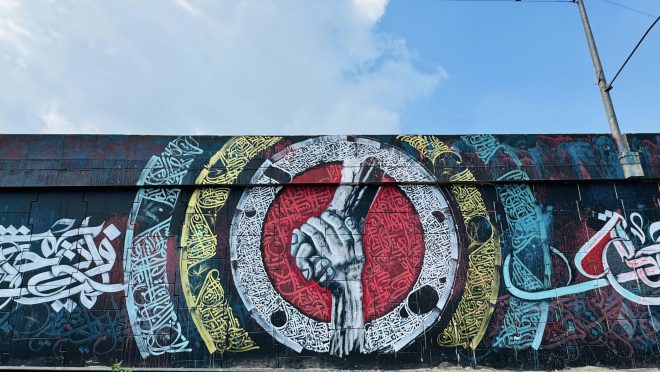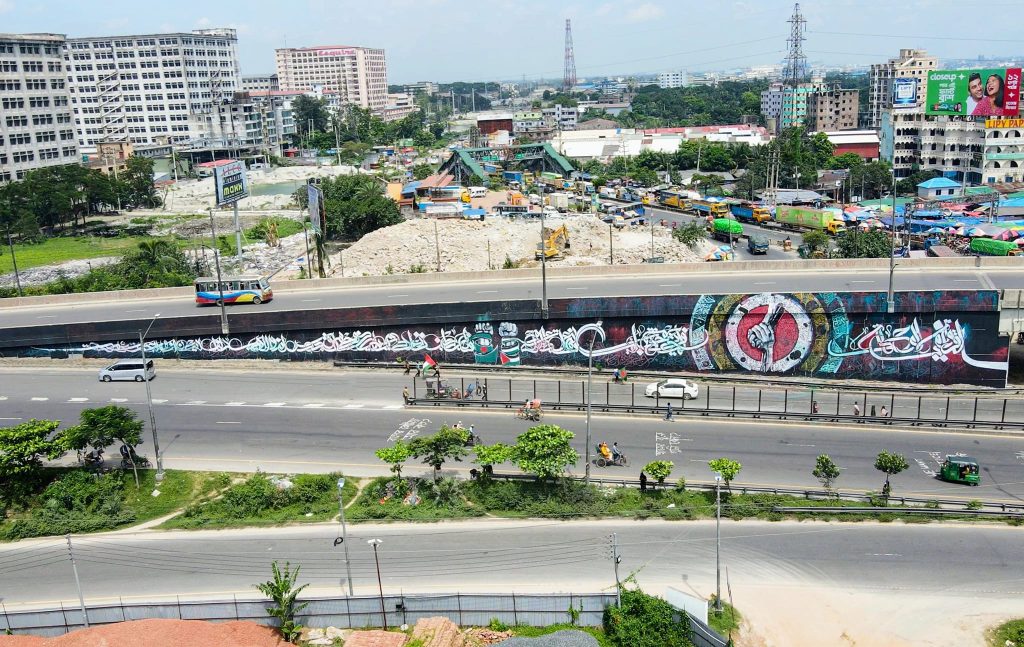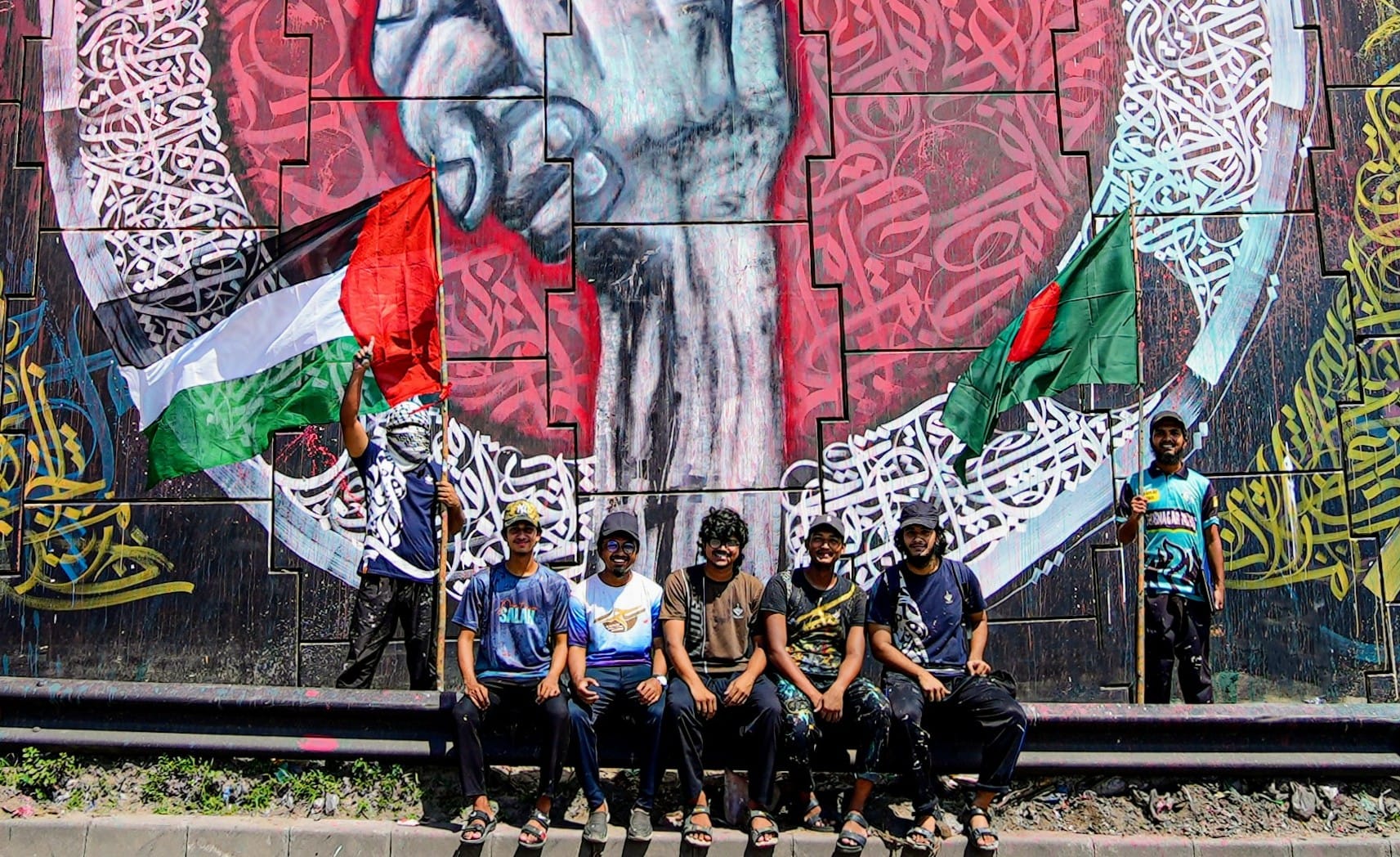Meet the mind behind one of the largest Arabic calligraphy in Bangladesh
Meet the mind behind one of the largest Arabic calligraphy in Bangladesh

Since July, following the student-led mass uprising, the public walls and pillars of bridges, flyovers, and metro rail stations in Bangladesh have transformed into canvases for a subtle yet powerful form of protest: graffiti.
Sometimes it’s just a one-line slogan like dofa ek daabi ek, Sheikh Hasinar podotyag (one point one demand—Sheikh Hasina’s resignation) or a beautiful artwork that captures the rebellious spirit of the revolution.
While most of these graffiti works have been in Bangla and English, recently there has been wide presence of Arabic graffiti featuring intricate calligraphy.
Among these, a 327-foot-long artwork on the walls of Kachpur Bridge in Narayanganj has caught everyone’s eye.

This stunning piece of art features brilliant Arabic calligraphy alongside powerful imagery. The calligraphy portrays poems promoting unity, with a spectacular depiction of two hands clasping each other in solidarity.
The Palestinian and Bangladeshi flags are prominently displayed, symbolising a shared struggle against oppression and a message of international brotherhood.
Who led the massive project?
We spoke with Mulla M Hanif, the lead calligrapher behind this massive project, to understand more about his artistic venture.

Hanif, who was once a madrasa student, has been a professional calligraphy artist since 2018. Since 2020, he has also worked as a calligraphy instructor, mentoring others in the art form.
What does the Arabic calligraphy say?
The graffiti begins from right with an Arabic poem that reads “Al quatu fil wahda” – “Unity is strength.”
At the centre of the mural, two enormous hands are depicted, with one lifting the other, symbolising solidarity and mutual support between nations. Surrounding this central image are words that evoke revolution (Inquilab), unity (Ittihad), and uprising (Intifada).
The presence of the Palestinian flag alongside the Bangladeshi flag speaks volumes about the brotherhood between the two nations and their shared fight against oppression.
Bangladesh has long been vocal about supporting Palestine’s right to self-determination, and this graffiti reflects that ongoing solidarity.
The mural even caught the attention of Al Jazeera Arabic, which featured Hanif’s work, recognising the powerful message behind it.
What inspired this project?
Hanif attributes much of his inspiration to fellow calligraphy artist Tausif Arafat Toha, a Fine Arts student at Dhaka University.
Hanif recalls, “Toha was probably the first in Bangladesh to start doing Arabic calligraphy on public walls. He began his work in 2021, and I met him in 2018. He taught me much of what I know about the art form.”
Hanif further explained how Toha introduced him to renowned calligraphy artists from the Middle East, such as Sayeed from Tunisia, whose works significantly influenced his style. “Gradually, I honed my skills to the level of expertise I have today,” he added.
The scale of the artwork
The graffiti spans 327 feet along the walls of Kachpur Bridge, with heights varying from 33 feet at the tallest point to 9 feet at the lowest. In total, the artwork covers an impressive area of around 6,000 square feet.
The team behind the masterpiece
The project was not a solo endeavour. Hanif led a team of 11 to 12 artists, who dedicated 12 days to completing the graffiti.

The materials for the project were donated by “Students Against Discrimination,” who have been supportive of public art initiatives in Bangladesh.
What’s next for Hanif?
Hanif is dedicated not only to his craft but also to spreading the knowledge of calligraphy. “I focus 50% of my time on my own work and the rest on teaching. I believe the more artists we train, the more we can achieve,” he said. Hanif has already started both offline and online courses, with plans to expand further.
“Our long-term goal is to cultivate more calligraphy artists. We’re planning to hold free workshops on calligraphy in different divisional areas of the country and recognise talented artists,” he shared.
As for his own future projects, Hanif intends to continue creating large-scale graffiti but maintains that his primary focus will remain on growing the community of calligraphy artists in Bangladesh.


